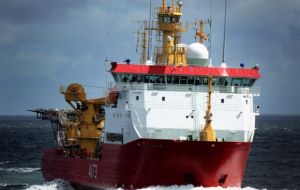MercoPress. South Atlantic News Agency
HMS Protector to assess fish stocks and update Ross Sea charts
 Ross Sea contains valuable fish stocks and Protector will help to ensure fishing vessels comply with the strict environmental rules for a sustainable resource.
Ross Sea contains valuable fish stocks and Protector will help to ensure fishing vessels comply with the strict environmental rules for a sustainable resource. Ice ship HMS Protector is heading for waters no Royal Navy vessel has visited in 80 years as she begins a marathon deployment to Antarctica. The Plymouth-based icebreaker and survey vessel will ensure the world’s fishermen are not stripping the largely-unspoiled waters of the Ross Sea of marine life.
This part of Antarctica – it’s where Norwegian explorer Roald Amundsen began his successful attempt to become the first person to reach the South Pole – has not seen a Royal Navy or UK Government vessel for around eight decades.
The sea contains valuable fish stocks and Protector will help to ensure fishing vessels comply with the strict environmental rules that ensure this remains a sustainable resource.
The Ross Sea lies around 2,000 miles from the ship’s normal survey area off the Antarctic Peninsula and the change of location for her work this winter means Protector is heading east, not south, visiting the Seychelles and Australia before heading down into the ice.
The ship has eight different ‘work packages’ planned in and around the frozen continent.
Those spells of intensive work, making use of the warmer temperatures and less inclement weather of the Austral summer, will focus on updating charts of the waters for the UK Hydrographic Office, monitoring wildlife and assisting the work of international inspectors who visit the numerous scientific bases peppered around Antarctic.
To support that varied work, the distinctive red-and-white ship carries small hi-tech survey motor launches which can conduct research where Protector herself cannot sail; a Royal Marines detachment, who provide both protection and also expertise in working in extreme temperatures; a specialist team of Royal Navy divers; and, for the first time, three tiny aircraft.
Protector has been given three 3D-printed micro-aircraft, identical to one tested on board HMS Mersey earlier this year off the Dorset coast.
The brainchild of experts at the University of Southampton and controlled from a laptop on board, it cruises at nearly 60mph and is all but noiseless thanks to its tiny engine. Each one costs no more than £7,000 – cheaper than an hour’s flying time by a Fleet Air Arm helicopter.
Each micro-aircraft can fly for up to 30 minutes, recording video footage on a miniscule camera, before setting down in the icy waters or on the snow and ice where it will be picked up by Protector’s ship’s company.
“The battery and engine should not suffer too much in the cold and once it’s airborne, it can fly in surprisingly rough weather,” said Prof Keane.
Protector is due to be away from the UK for 20 months until the spring of 2017. One third of her crew – there are typically around 50 men and women aboard – rotates every few weeks to sustain the ship on operations.




Top Comments
Disclaimer & comment rules-

-

-

Read all commentshas not seen a Royal Navy or UK Government vessel for around eight decades.
Oct 15th, 2015 - 10:29 am 0until now,
Royal Navy=anywhere anytime any place.,
now listen for the screaming CFK crying.
In the meanwhile the ARA Irizar is still “under” maintenance, and repair, work. Another example of a peronist sovereignty empty talk without being part of the daily reality.
Oct 15th, 2015 - 12:37 pm 0Enriqueeeeeee !!!!......Axeeeeelllll !!!!.....where are you now?
Perhaps we'll have evidence of where the argie thieves are poaching. Have the micro-aircraft been tested to see whether they can carry and drop bombs?
Oct 15th, 2015 - 02:49 pm 0Commenting for this story is now closed.
If you have a Facebook account, become a fan and comment on our Facebook Page!